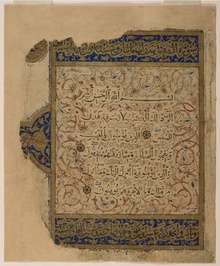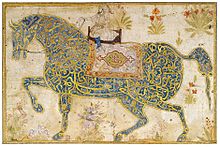Al-Baqarah
Al-Baqarah (Arabic: البقرة, "The Heifer" or "The Cow") is the second and longest chapter (sūrah) of the Quran.[1] It consists of 286 verses (āyāt), 6,201 words and 25,500 letters.[2]
| البقرة Al-Baqarah The Heifer | |
|---|---|
| Classification | Medinan |
| Position | Juzʼ 1–3 |
| No. of Rukus | 40 |
| No. of verses | 286 |
| Opening muqaṭṭaʻāt | Alif lam Meem |
| Quran |
|---|
 |
|

It is a Medinan surah, that is to say that it was supposedly revealed at Medina after the Hijrah, with the exception of the verses with regard to riba (interest or usury) which Muslims believe were revealed during the Farewell Pilgrimage, the last Hajj of Muhammad.[3][4] in particular, Verse 281 in this chapter is believed to be the last verse of the Quran to be revealed, on the 10th of Dhul al Hijjah 10 A.H., when Muhammad was in the course of performing his last Hajj, and only 80 or 90 days later he died.[5]
Surah al-Baqarah (Quran 2) enjoins fasting on the believer during the month of Ramadan.[6]
Background
It is the longest chapter in the Quran and was revealed over a long period. It is a Mediniite Surah dealing with the Hypocrite (Munaafiqoon) and injunctions pertaining to various matters.
It includes many verses which have virtues like the first four and last three verses and the special Verse of the Throne (Aayatul Kursi). Muhammad is reported to have said,
“Do not turn your houses into graves. Verily, Satan does not enter the house where Surat Al-Baqarah is recited.” [Muslim, Tirmidhi, Musnad Ahmed]
Ad-Darimi also recorded that Ash-Sha`bi said that `Abdullah bin Mas`ud said, "Whoever recites ten Ayat from Surat Al-Baqarah in a night, then Satan will not enter his house that night. (These ten Ayat are) four from the beginning, Ayat Al-Kursi (255), the following two Ayat (256-257) and the last three Ayat.
Theme and subject matter
The surah addresses a wide variety of topics, including substantial amounts of law, and retells stories of Adam, Ibrahim and Musa. A major theme is guidance: urging the pagans (Al-Mushrikeen) and the Jews of Medina to embrace Islam, and warning them and the hypocrites (Munafiqun) of the fate God had visited in the past on those who failed to heed his call.[7]
The stories in this chapter are told to help the reader understand the theological conception of truth in Islam.[8]
Surah Baqarah also mentions three qualities of the God-fearing (Al-Muttaqin), that is those who possess Taqwa: 1) They believe in the unseen. Faith (Imaan) is believing and accepting something one cannot see i.e. trusting in Muhammad and the Quran. It is believing everything which is part of Imaan, the Angels, destiny etc. 2) They establish Prayer (Salah). The major sign of a person with Taqwa is they perform Prayer/Salaah. “Establishing” Salaah is fulfilling its requirements, internally with feelings in the heart, and externally fulfilling its requirements (Wudu, compulsory elements (Fard), Sunnahs, reciting with tajwid etc.) and feeling a connection with Allah. In a tradition or hadith, Muhammad said, “Prayer is the Mi’raaj of a Mu’min” and in Mi’raaj he spoke to Allah. (In the Surah preceding Surah Al Baqarah, i.e. Surah Fatiha Muslims are believed to have a dialogue with Allah). 3) They spend from what Allah has given them, as this is a form of worship too- namely, considered a financial worship. Spending in the way of God (i.e. giving Sadaqah), is to spend from what Muslims believe that Allah Himself gave them. Sadaqah comes from “Sidq” which means “True” as it shows the truth of a Muslim's Imaan (faith).
2:8-20 The hypocrites
Q2:8-20 in Surah Al Baqarah refer to the hypocrites (Munafiqun). In the Meccan phase of Muhammad, there existed two groups, the Believers and the Mushrikeen (non-believers). However, after Hijrah (Emigration to Medina) Muhammad had to deal with the opposition of those who openly accepted Islam while secretly plotting against Muslims. Their leader was Abd-Allah ibn Ubayy who was about to be crowned king before the arrival of Muhammad in Medina. The hypocrites benefitted from the Muslims while not losing their association with the disbelievers. They were considered disloyal to either parties and inclined towards those who benefited them the most in the worldly sense
The surah also sheds light on the concept of Nifaq, which is opposite of sincerity. It is of two types:
1) Nifaq in belief: outwardly showing belief however in reality there is no belief 2) Nifaq in practice: where people believe however they act like hypocrites. The signs of a hypocrite are lying, breaking promises, not keeping an amaanah or trust and when they argue they curse or use bad language.
According to a prominent scholar, Kamaluddin Ahmed, Nifaq is something that is within the heart, hence no one knows of its existence except Allah. Therefore, no one can be called a hypocrite or Munaafiq through one's own self-assessment. This would amount to making Takfeer i.e. calling someone a Kafir (non-believer) since Nifaq (hypocrisy) in belief is kufr.
Q2:26 Commences with ۞[9] (rubʿ al-ḥizb), an Islamic symbol.
Q2:87-105 is preserved in the Ṣan‘ā’1 lower text.[10]
- And We did certainly give Moses the Torah and followed up after him with messengers. And We gave Jesus, the son of Mary, clear proofs and supported him with the Pure Spirit. But is it [not] that every time a messenger came to you, [O Children of Israel], with what your souls did not desire, you were arrogant? And a party [of messengers] you denied and another party you killed. [Q2:87][11]
Condemnation of alcoholic beverages and gambling is also first found in the chapter,[12] and it is one of only four chapters in the Quran to refer to Christians as Nazarenes instead of the more frequent terms People of the Book or "Helpers of Christ."[13]
Al-Baqarah contains several verses dealing with the subject of warfare. Q2:190-194 are quoted on the nature of battle in Islam.
The surah includes a few Islamic rules related to varying subjects, such as: prayers, fasting, striving on the path of God, the pilgrimage to Mecca, the change of the direction of prayer (Qiblah) from Jerusalem to Mecca, marriage and divorce, commerce, debt, and a great many of the ordinances concerning interest or usury.[7]
2:255 "The Throne Verse"
Verse 255 is "The Throne Verse" (آية الكرسي ʾāyatu-l-kursī). It is the most famous verse of the Quran and is widely memorized and displayed in the Islamic world due to its emphatic description of God's omnipotence in Islam.
Verse 256 is one of the most quoted verses in the Quran. It famously notes that "there is no compulsion in religion". Two other verses, 285 and 286, are sometimes considered part of "The Throne Verse".[14]
2:282 "Verse of Loan and Women's testimony"
Verse 2:282[15] covers two specific Islamic jurisprudence issues: (1) undertaking a loan and (2) the status of women's testimony.
Amin Ahsan Islahi in his Tafsir of Surah al-Baqarah says when there is a loan transaction for a specific period of time, it must be formally written down. Both the lender and the debtor must trust the writer. There must be two witnesses: two men, or one man and two women. The security of the writer must be guaranteed. The length of the contract should be stated exactly.[16][17]:2:282
al-Jalalayn says, "summon to bear witness the debt two witnesses men mature Muslim free men; or if the two witnesses be not men then one man and two women"[18][17]:2:282
Structure
Some have remarked that Surat al-Baqarah appears to be arranged in ring composition structure. The structure of the surah forms a ring, where the first themes resemble the last themes, the second themes resemble the second last themes, and so on. The middle theme group includes verse 143 of the surah, that talks about the change in prayer direction.
It is also worth noting that the 143rd verse of surat al-Baqarah, which is composed of 286 verses, contains the word "middle" (143 is half of 286)[19][20]
See also
- Ayatul Kursi
- Verse of Loan
References
- Salwa M. S. El - Awa, Introduction to Textual Relations in Qur'an, pg. 1. Part of the Routledge Studies in the Qur'an series. London: Routledge, 2005. ISBN 9781134227471
- Ibn Kathir
- Mahmoud Ayoub, The Qurʾan and its interpreters, pg. 55. Albany: State University of New York Press, 1984. ISBN 9780791495469
- Maariful Quran
- Qurtubi
- Michael Binyon, Fighting is 'allowed' during the holy month of fasting The Times, 18 December 1998
- Sadr-'ameli Sayyid Abbas. "Surah Al-Baqarah, Chapter 2, Introduction". Al-islam. Retrieved 14 May 2015.
- R. G. Ghattas and Carol B. Ghattas, A Christian Guide to the Qur'an: Building Bridges in Muslim Evangelism, pg. 40. Kregel Academic, 2009. ISBN 9780825493423
- https://quran.com/2?translations=20
- Behnam Sadeghi & Mohsen Goudarzi, "Sana'a and the Origins of the Qu'ran", Der Islam, 87 (2012), 37.
- Q2:87 Sahih International
- Kathryn Kueny, The Rhetoric of Sobriety: Wine in Early Islam, pg. 66. Albany: State University of New York Press, 2001. ISBN 9780791450536
- Karen Steenbrink, "Muslims and the Christian Other: Nasara in Qur'anic Readings." Taken from Mission is a Must: Intercultural Theology and the Mission of the Church, pg. 200. Eds. Frans Jozef Servaas Wijsen and Peter J. A. Nissen. Volume 40 of Church and Theology in Context Series. Amsterdam: Rodopi, 2002. ISBN 9789042010819
- Prana Dev (2010). Spiritual Quest of a Baby Yogi: Journey Through Islam, Christianity, and Beyond. ISBN 978-1-4502-6904-9.
- "Quran 2:282 Translation Yusuf Ali (Orig. 1938)". Islam Awakened. Retrieved 7 May 2020.
- Amīn Aḥsan Iṣlāḥī (2007). Tafsir of Surah al-Fātihan and Surah al-Baqarah. The Other Press. ISBN 978-983-9154-88-7.
- Ibn Kathir. "Tafsir Ibn Kathir (English): Surah Al Baqarah Pt II". Quran 4 U. Tafsir. Retrieved 22 December 2019.
- al-Jalalayn. "The Tasfirs". altafsir.com. Retrieved 7 May 2020.
- Raymond,, Farrin,. Structure and Qur'anic interpretation : a study of symmetry and coherence in Islam's holy text (First ed.). Ashland, Oregon. ISBN 9781935952985. OCLC 860756355.CS1 maint: extra punctuation (link)
- "Surah Al-Baqarah [2:143]". Surah Al-Baqarah [2:143]. Retrieved 2019-02-12.
External links
| Wikisource has original text related to this article: |
- "The Cow", a manuscript, dating from the 13th-century, of the al-Baqarah via the World Digital Library
- Qur'anic Verses, a manuscript for al-Baqarah from the 13th-century
- Quran 2 Sahih International translation
